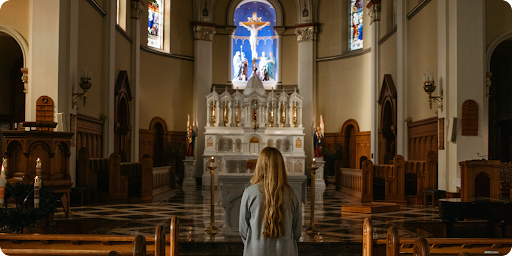The Doxology
Father Luke Spannegal
Today we are in the homestretch of our journey through the Eucharistic Prayer of the Mass! At the conclusion of the Eucharistic Prayer, the priest prays some very special words: The Doxology. The glossary of our Catechism defines doxology as a “Christian prayer which gives praise and glory to God, often in a special way to the three divine persons of the Trinity” (CCC, 875). The Catholic Source Book tells us the word doxology comes from the Greek doxa, which means “glory.” In our tradition, the Gloria can be referred to as the “Greater Doxology” and the prayer “Glory Be” the “lesser doxology” (The Catholic Source Book, p. 7). There are many doxologies found throughout our prayer, including those in the Bible. For example: “For from him and through him and for him are all things. To him be glory forever. Amen.” (Romans 11:36). Another example is: “To him be glory now and to the day of eternity” (2 Peter 3:18).
Gratitude for Participation in Jesus’ Offering
As for the doxology of the Eucharistic Prayer, the priest raises the chalice and paten, and sings or says: “Through him, and with him, and in him, O God, almighty Father, in the unity of the Holy Spirit, all glory and honor is yours, for ever and ever.” As the Diocese of Peoria teaches, “These words of praise addressed to the Father summarize well the reality of what has just taken place: the sacrificial offering of the Son to the Father through the Holy Spirit” (A Study of the Mass, p. 16). For me as a priest, this is always a truly special moment where I feel an overlapping mix of unworthiness and joy. Elevating Jesus in the Eucharist above the altar, I am often struck with a sense of being allowed to participate in something truly amazing! Here is Jesus truly present, being offered to the Father through this moment in the Mass. This moment of elevation reminds me of Jesus on the Cross—lifted up, giving everything in love for us. As I hold Jesus up above the altar, I feel that the gesture is saying to God the Father: “Here is Jesus, your Beloved Son; here is the One who loves us perfectly and gave everything for us!”
Fr. Guy Oury mentions this “offering gesture” and how “the offering is that of the Son and at the same time that of the Church. The Mass is inseparably both—an offering made by Christ and by the Church. It is one through the other. The sacrifice of Christ makes possible the sacrifice of the Church and evokes it in response. The Church, to speak in figure, receives the offering from the hands of Christ. He instituted it for the Church, which presents it with him” (The Mass, p. 103). I’m often amazed at the humility of Jesus: in his generosity and love, he invites us through the priest to join in this moment of offering and praise!
United with the Church, Both on Earth and in Heaven
Charles Belmonte breaks down the words of this doxology, highlighting the ways we are invited into this moment through Jesus, “Through him: Through Jesus’ mediation, we have access to God… With him: We are children of God, through the adoption Christ merited for us… In him: There is one and the same life in him and in us… In the unity of the Holy Spirit: The Church is a unity brought together by the Holy Spirit. He joins us together as believers and gives us the life of grace by which we become children of God. He dwells in us, enabling us to offer the sacrifice of praise to God, together with the entire Church”.
This moment of the Mass brings us to the great culmination of the Eucharistic Prayer and the one perfect sacrifice of Jesus. As some saints have reminded us, in a very real way we are joined with the angels and saints in the heavenly liturgy. As Jesus is offered to the Father through the Holy Spirit, it seems that all of creation should burst forth together in praise and joy. How can we hold back in the midst of such a wonderful gift? As we will see, we all have a response at this moment that praises God: The Great Amen!
For Reflection:
1. When you pray the “Glory Be,” imagine the elevation of the paten and chalice during the Eucharistic Prayer and unite your prayer with the offering of Christ.
2. As you make decisions about what you give and what you receive today, consider how these acts of offering do or do not glorify God. At moments when you receive or give human praise, direct your heart to give glory to God.




